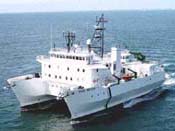
The R/V Thomas G. Thompson at sea. Note the A-frame at the stern of the ship, and the large crane forward of the stern. The Thompson is 274 ft. in length with a 52.5 ft. beam. Click image for a larger view.
Research Vessel
Thomas G.
Thompson
The R/V Thomas G. Thompson was built and is owned by the U.S. Navy, and is operated by the University of Washington (UW). The Thompson, also referred to as AGOR-23, was delivered to UW in July 1991. Since then, it has spent an average of 250-315 days at sea per year on scientific and educational missions.
The Thompson measures 274 ft. in length and 52.5 ft. of beam (width). Its draft (the amount of ship below the water line) with a full load is 19 ft., displacing 3,250 tons of water. Normal cruising speed for the Thompson is 13 knots, with a maximum speed of 14.5 knots. At a speed of 14 knots the ship can be at sea for 33 days. The Thompson is propelled by two 3,000 HP engines in the stern (360 degree azimuthing stern thrusters), as well as one 100 HP water jet bow thruster which assists the stern engines by providing power at the bow of the ship. The ship is equipped with sophisticated satellite equipment (2 Trimbal GPS receivers and a Northstar Differential GPS receiver) which determine its position at sea and aid in navigation. Palegos Winfrog, an integrated navigation system, is used to display the ship’s position. The ship is equipped with 3 winches, 3 cranes and an A-Frame. The A-Frame can hold a 12 ton static load, 6 tons in motion.
Science and Research Support
The R/V Thompson is an excellent vessel for conducting multidisciplinary research projects that involve large teams of scientists. The vessel can bearth up to 36 scientific personnel as well as 22 officers and crew and two marine technicians. The working space for research includes a number of laboratories. There is a 235 sq. ft wet lab, where rock and other samples can be examined. Another lab measuring 820 sq. ft. is most definitely not for wet activities, as it contains sophisticated computers and other electronic equipment. There is also a 359 sq. ft. “clean lab” which is designed for careful chemical and biological analytical work. The largest lab on the ship measures 1730 sq. ft. The ship also houses a 700 sq. ft. "Hydro" lab, from where highly sophisticated operations such as ROV and AUV work are directed. There is also a 380 sq. ft. staging bay and two large storerooms for scientific equipment and supplies.

The main deck of the R/V Thompson. Notice the large amount of laboratory space for scientific personnel. Exploring the Submarine Ring of Fire mission will use the back deck for staging ROV ROPOS and AUV ABE operations. Click image for a larger view.
While the scientists using the Thompson bring with them specialized equipment relevant to the work that they will do at sea (such as ROV and AUV operations), the ship is already equipped with a vast amount of scientific equipment and instrumentation on board. There are multiple systems for looking at the ocean bottom and determining water depths and bathymetry (undersea topography), including a Simrad EM300 (30 kHz) multibeam system, a 3.5 kHz sub-bottom system, two 12.0 kHz bottom profilers and an ODEC Bathy-2000 (used for bottom and sub-bottom profiling). On board is also a state-of-the-art CTD, which measures water properties including salinity, temperature, pressure, and chemistry. The SeaBird SBE-911 + CTD includes sampling bottles that can be used to collect water at any depth, as well as measures light transmission in the water column. A 150 kHz Acoustic Doppler Current Profiler (ADCP) is available to measure water currents from the moving ship. Internet and network capabilities, as well as access to the shipboard sensors, are provided throughout the ship by ethernet hookups distributed by fibre-optic cable.
The scientists and ship personnel on board are split into “watches” so that a crew of people is always working, collecting data and managing the ship, 24 hours a day. The mess (the cafeteria, in ship-speak) serves three meals a day and late-night snacks to the hungry crew and scientists. Recreational facilities on board include a TV lounge, library, ping pong table and exercise room. Personnel on the ship can even fish from the ship in their spare time!
In 2002, the Thompson will conduct research and educational cruises throughout the Pacific, including Hawaii, Guam, Puget Sound, and the East Pacific at Explorer Ridge.
Click here to learn more about the R/V Thompson.















